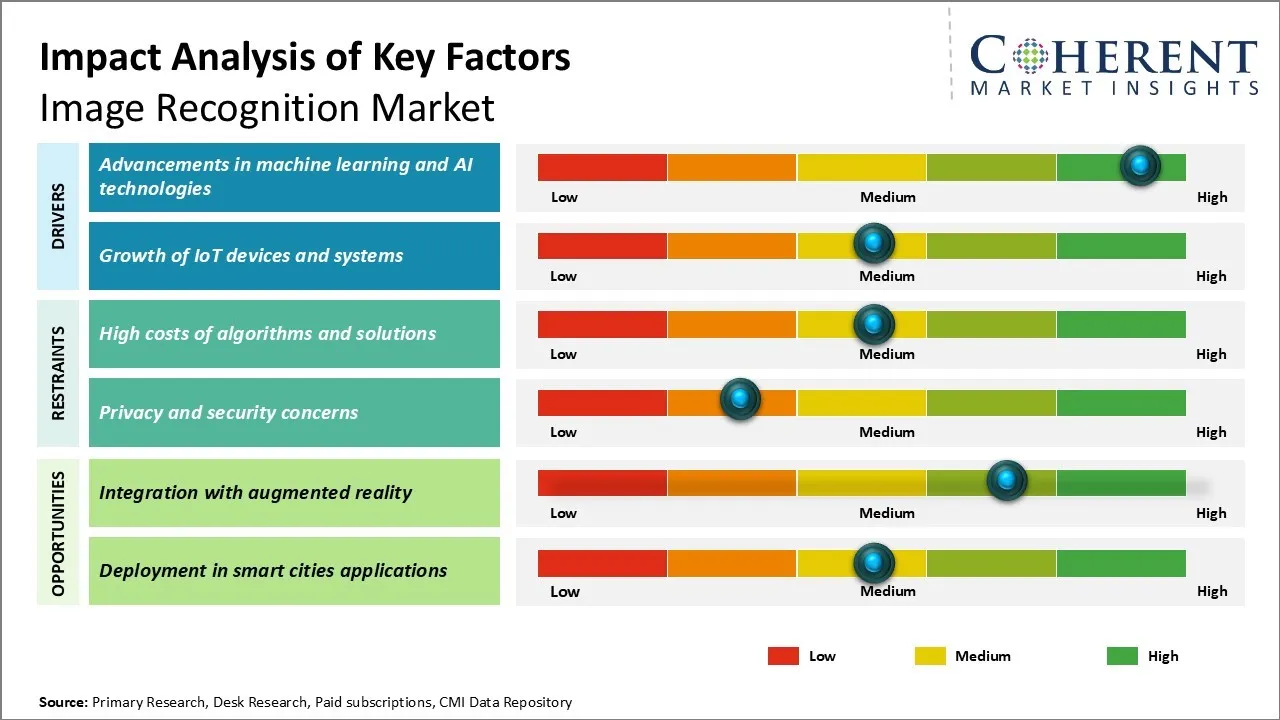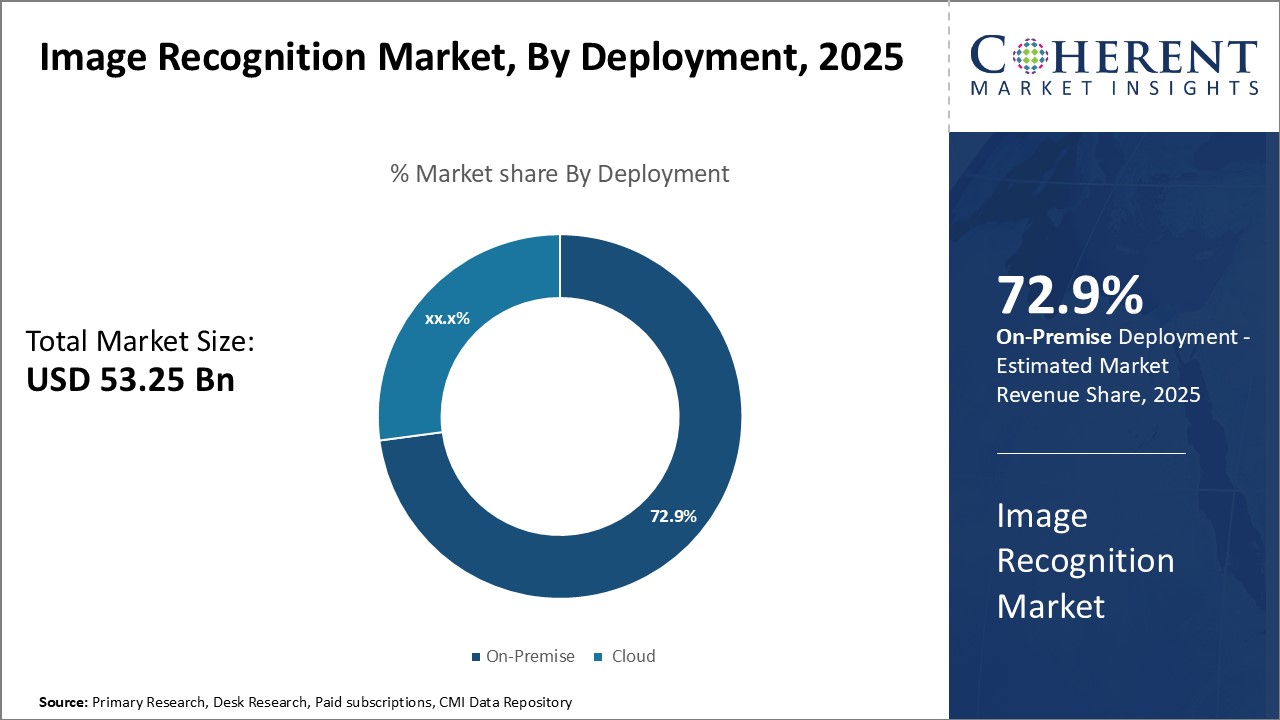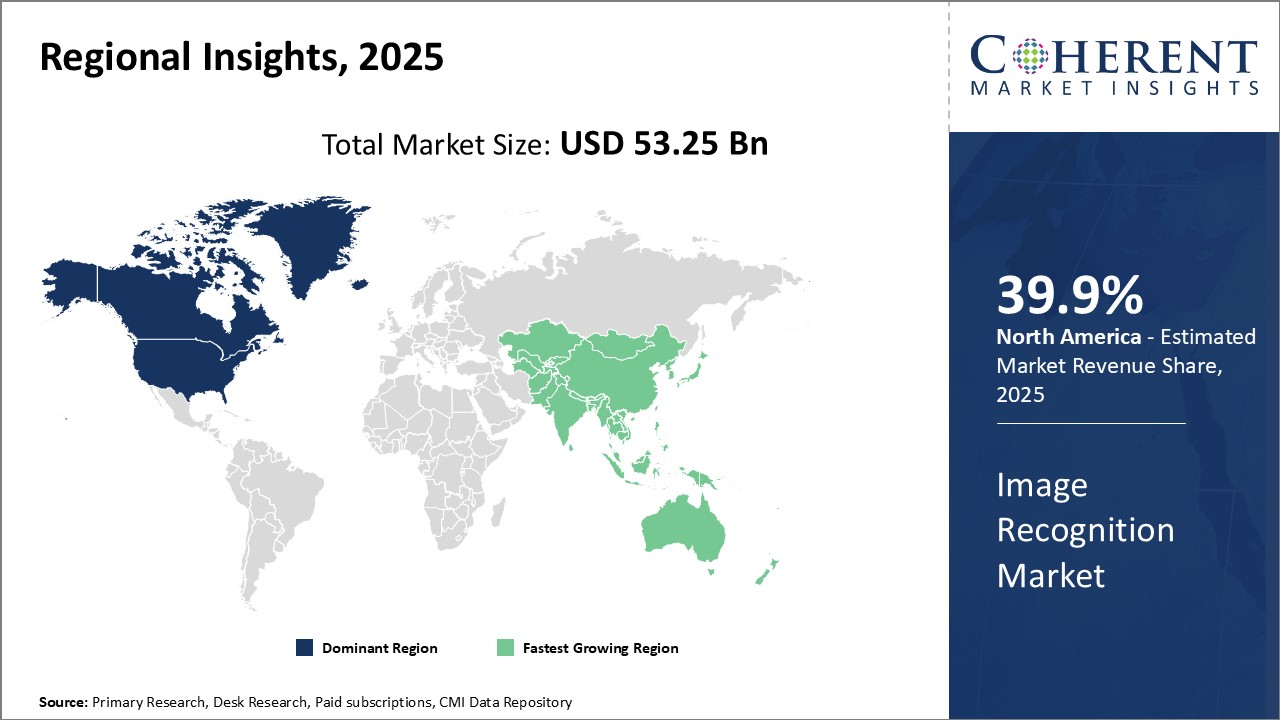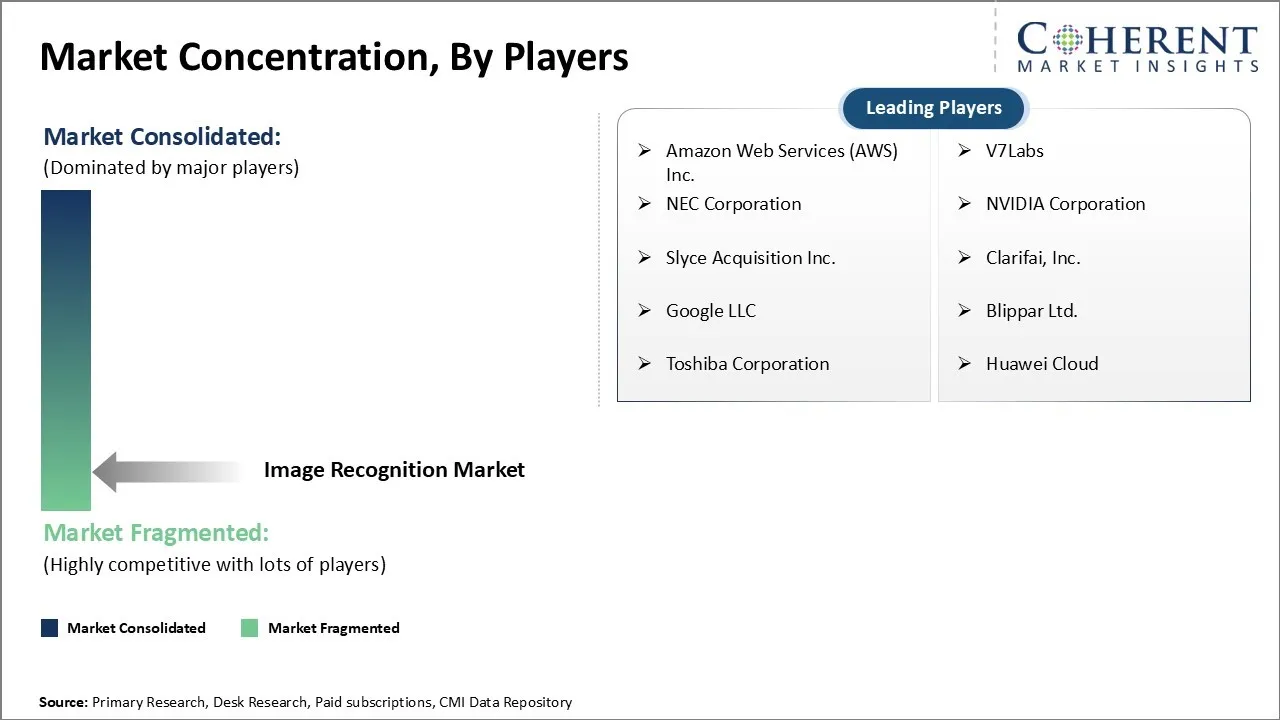The Global Image Recognition Market is estimated to be valued at US$ 53.25 Bn in 2025 and is expected to reach US$ 146.10 Bn by 2032, growing at a compound annual growth rate (CAGR) of 15.5% from 2025 to 2032.

Discover market dynamics shaping the industry: Request sample copy
The image recognition market is experiencing robust growth, driven by advancements in artificial intelligence (AI) and machine learning (ML). This technology enables computers to identify and process images as humans do, finding applications across numerous sectors like retail, healthcare, automotive, and security. Image recognition is pivotal in facial recognition for security, autonomous vehicles, diagnostics in healthcare, and customer engagement in retail. The global market is expanding, especially in regions like the U.S., China, and Europe, where industries heavily invest in AI integration. With rising demand for automation, real-time data processing, and personalized experiences, the market is expected to continue growing significantly in the forecast period.

Discover high revenue pocket segments and roadmap to it: Request sample copy
Insights, By Deployment, Enhanced Control Drives Adoption of On-Premise Image Recognition Solutions
By Deployment, On-Premise is expected to account for highest market share of 72.9% in 2025 owing to enterprises prioritizing data security and control. On-Premise solutions allow organizations to host image recognition systems and data within their internal infrastructure behind a firewall. This ensures sensitive information such as personally identifiable images stays within the organization's control and purview.
Insights, By End-use, Growth in Fintech drives BFSI uptake of Image Recognition
By End-use, BFSI is expected to contribute 28.1% in 2025 primarily due to the proliferation of new financial technologies. The banking and insurance industry is increasingly embracing image recognition to digitize verification processes and automate critical back-office functions. Image analysis also helps detect fraud by comparing user images with databases. Emerging fintech solutions such as mobile check deposit, low-code lending platforms and robo-advisory heavily rely on computer vision. It is streamlining traditionally paper-intensive workflows in areas such as underwriting, claims processing and customer on-boarding.
Insights, By Component, Ubiquity of software fuels the largest share of Image Recognition market
By Component, Software contributes the highest share of the market since it acts as the backbone for any computer vision deployment. Image recognition software encompasses both proprietary as well as open-source computer vision and deep learning algorithms that can be integrated into various applications. The standalone and plug-and-play nature of such visual analytics solutions allows for seamless adoption across industries without significant infrastructure investments.

Need a Different Region or Segment? Customize now
Dominating Region: North America
In North America, the dominance in the image recognition market share is estimated to be 39.9% in 2025. It is driven by factors such as strong technological adoption, significant investment in AI and computer vision startups by tech giants and venture capital firms, and supportive government initiatives that promote innovation.
Fastest-Growing Region: Asia Pacific
Meanwhile, the Asia Pacific region exhibits the fastest growth owing to increasing industrial automation across manufacturing, presence of emerging economies like China and India with large population and rapid digitization initiatives by governments and private organizations.
Image Recognition Market Outlook for Key Countries
U.S. - The U.S. leads the image recognition market globally, with significant R&D and technological innovations. High adoption of AI-powered applications in sectors like e-commerce, retail, healthcare, and security; strong presence of tech giants like Google, Apple, and Amazon investing heavily in image recognition technology.
China - China is a close competitor to the U.S. and one of the fastest-growing image recognition markets, driven by state support and strong consumer demand. The market is driven by extensive government support for AI initiatives, large-scale adoption in surveillance and security, and increased investments in e-commerce and financial technology.
Japan - Japan continues to lead in industrial imaging solutions with manufacturers like Omron and Keyence investing in deep-learning based quality inspection systems. It has a well-established infrastructure with a focus on precision-driven applications, emphasizing robotics and automation in manufacturing. Image recognition is widely used in retail, healthcare, and security along with integration of AI in consumer electronics and automotive sectors.
India - India is an emerging market with vast potential due to a large population and increasing adoption of digital technology. The growing adoption of image recognition in retail, healthcare, and financial services; government initiatives is capable of improving digital infrastructure and smart city projects; high mobile and internet penetration.

Get actionable strategies to beat competition: Request sample copy
Top Strategies Followed by Image Recognition Market Players:
Established Players- R&D Investment
Leading companies focus extensively on research and development to drive innovation. For instance, companies like Microsoft, IBM and Google invest over 10% of their annual revenues in R&D to develop high-performance image recognition products using cutting-edge AI and machine learning technologies. These companies also pursue strategic partnerships to strengthen their market position. Microsoft has partnerships with automotive giants like Volkswagen to integrate its image recognition APIs into vehicle systems. IBM partners with retailers to deploy visual search capabilities on their ecommerce platforms. Global expansion is another key strategy. Companies expand their sales and distribution networks internationally to cater to the growing global demand. For example, NEC established regional offices in the U.S., Europe and Asia in the last five years to sell its biometric authentication solutions to a wider customer base.
Mid-Level Players- Cost-Effective Solutions
These players emphasize on delivering cost-effective solutions. For instance, Anthropic focuses on developing general purpose image classification models and makes them accessible through affordable APIs and SDKs targeting price-sensitive SMBs. Collaborations help mid-tier players enhance their capabilities. Anthropic partners with various AI safety non-profits and universities to strengthen its tools for building responsible AI models. Clarifai collaborates with drone manufacturers to optimize its aerial imagery analysis models.
Emerging Startups in the Image Recognition Market
Innovative Technologies: Startups like Anthropic, Appen and Scale AI are leveraging cutting-edge technologies like self-supervised learning and transfer learning to develop advanced image recognition models that can match or surpass human-level performance. Their technologies could make visual AI more pervasive.
Sustainable Solutions: Sortera Alloys employs AI-driven image and data analytics to revolutionize the recycling of industrial scrap metals, facilitating the conversion of recycled materials into new tech products. Recycleye develops image recognition tools for the waste management sector, automating the identification and sorting of recyclables to promote sustainable waste practices.
Market Contribution: Startups also address unique industry needs. Grover uses AI-guided inventory auditing to help retailers optimize stock management and reduce losses. Anthropic assists companies in implementing responsible AI practices.
Key Takeaways from Analyst
The global image recognition market is poised to grow significantly over the forecast period. It is experiencing strong growth across multiple industries, including healthcare, retail, automotive, agriculture, and security. The market is likely to expand as image recognition technology becomes more accurate, accessible, and integrated with other AI-powered solutions.
On-premises solutions are expected to witness the fastest growth as demand for real-time solutions is high. North America currently dominates the market due to heavy spending on R&D. However, Asia Pacific is likely to offer lucrative opportunities attributed to favorable market conditions, rise in disposable incomes, growing emphasis on security and surveillance industry in China, India, and Southeast Asia.
On the flip side, high costs of solutions may negatively impact the market growth especially during the transitioning phases from traditional to modern methodologies. Furthermore, the privacy and security concerns pose challenges for third-party vendors. Overall, the opportunities outweigh the challenges as Image recognition finds increased applications in airport security and surveillance, public and personnel safety.
Image Recognition Market Report Coverage
| Report Coverage | Details | ||
|---|---|---|---|
| Base Year: | 2024 | Market Size in 2025: | USD 53.25 Bn |
| Historical Data for: | 2020 To 2024 | Forecast Period: | 2025 To 2032 |
| Forecast Period 2025 to 2032 CAGR: | 15.5% | 2032 Value Projection: | USD 146.10 Bn |
| Geographies covered: |
|
||
| Segments covered: |
|
||
| Companies covered: |
Amazon Web Services (AWS) Inc., V7Labs, NEC Corporation, NVIDIA Corporation, Slyce Acquisition Inc., Clarifai, Inc., Google LLC, Blippar Ltd., Toshiba Corporation, Huawei Cloud |
||
| Growth Drivers: |
|
||
| Restraints & Challenges: |
|
||
Uncover macros and micros vetted on 75+ parameters: Get instant access to report
Market Driver - Advancements in Machine Learning and AI Technologies
As the capabilities of machine learning and artificial intelligence technologies continue to advance at a rapid pace, it is fueling greater adoption of image recognition solutions across various industries. Deep learning algorithms which rely on neural networks that can recognize visual patterns in images are allowing image recognition to move beyond basic object detection to more complex tasks. With the proliferation of Internet of Things (IoT) devices including smart cameras, IP cameras, CCTV cameras, drones and other types of sensors, there is a rapidly expanding generation of digital visual data being created every minute. McKinsey estimates that the number of IoT connected devices is expected to cross 20 billion units globally by 2025. All these devices equipped with cameras or other vision sensors produce huge volumes of images and videos on a daily basis. However, analyzing and deriving useful insights manually from this deluge of visual IoT data is simply not feasible.
Market Challenge - High Costs of Algorithms and Solutions
The image recognition market faces significant challenges due to the high costs involved in developing sophisticated algorithms and end-to-end solutions. Creating computer vision systems that can accurately identify and classify objects requires massive datasets for training deep learning and neural networks. The collection, annotation and labeling of image data is a lengthy and expensive process. Additionally, cutting-edge hardware infrastructure is needed to run complex convolutional neural networks in a timely manner. This involves substantial investment in GPU servers, storage solutions and cloud computing resources. For smaller companies and startups, acquiring such capabilities srequires large capital outlays that are difficult to finance in the early stages.
Market Opportunity - Integration with Augmented Reality
One of the major opportunities for the image recognition market is in the realm of augmented reality (AR) and augmented intelligence. As AR technologies mature and begin to proliferate across various platforms like smartphones, wearables and smart glasses, there will be immense scope for leveraging image recognition capabilities. AR heavily relies on computer vision algorithms to detect and understand the physical environment. Image analysis plays a key role in accurately overlaying virtual objects and graphics seamlessly within the user's field of view.
Share
Share
About Author
Monica Shevgan has 9+ years of experience in market research and business consulting driving client-centric product delivery of the Information and Communication Technology (ICT) team, enhancing client experiences, and shaping business strategy for optimal outcomes. Passionate about client success.
Missing comfort of reading report in your local language? Find your preferred language :
Transform your Strategy with Exclusive Trending Reports :
Frequently Asked Questions
Joining thousands of companies around the world committed to making the Excellent Business Solutions.
View All Our Clients